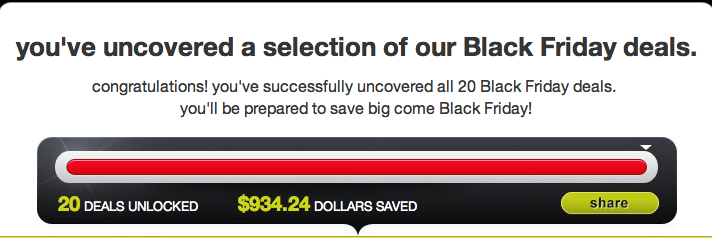
Gamification opponents are often quick to point out the flaws in gamification, calling poorly designed experiences as “pointsification” with uninspired and non-additive game design elements in place. These are fair criticisms when the gamified experiences in question are indeed uninspired and non-additive. Such is the case when I noticed a sponsored Facebook ad by Target that wanted me to “Play Now to Unlock Black Friday Deals” and after playing I realized that this is a prime-example of a poorly gamified experience.
The experience can be distilled into a very simple procedure: click on one of two items to guess which item will be on sale on Friday. Guessing correctly will reveal that item in a grid. Each correct guess will then increase a progress bar according to how much money you’d be saving if you were to buy every of the 20 “secret” items that is displayed on the page. The game ends when you successfully have guessed the 20 items for sale with an opportunity to share this “accomplishment” on Facebook. And once you’ve completed all of this…you realize you haven’t gotten anywhere new than where you first started.
Gamification for the sake of gamification fails

The first major flaw in the mere concept of this “game” is that the gamification elements employed here are just obstacles that prevent the user from finding out information that is already readily available. They tried to mask this by tantalizing the users with opportunities to find out about Black Friday deals early but their entire Black Friday circulars are all readily available already. Game elements should enhance the experience of receiving these deals. If instead users were made to choose which products they would have liked to save money on and by doing so, the app then creates a map of the most effective route of getting those products at their local Target, there would be added value by interacting with the game elements. Users simply end up progressing through the game to nowhere…which brings me to my next point.
Progress needs to relate to action

Experience/progress bars exist to give the user feedback about their actions as it relates to how close they are to completing a goal. There is a disconnect between the information being displayed in the progress bar, which is the amount of money saved on each deal and the objective being asked of the player, which is to discover Target’s Black Friday deals. Seeing the progress bar move might provide a favorable progressive feelings but once the user finishes the game by guessing all twenty items, the user is left with an arbitrary final total. After finishing this game, I now know I could’ve saved $934.24 on twenty random items I didn’t choose and definitely won’t buy. As a user, the choices I have made did not bear any weight on my finishing of the game, whereas completing the profile progress bar in LinkedIn, could be very important to prospective employers.
Share for a reason
Yes, social is nearly essential to every experience that exists these days but please make social experiences actually social.Letting others know that I’ve saved $900 on handful of random items does not make for conducive social interaction nor does it entice others to try your gamified experience either. If sharing could allow my friends to have a different experience than I did and then allow the two of us to compare our results, then that would be far more compelling.
I recognize that actually experiencing Black Friday is a pretty awful in itself but this gamified experience did not have to feel like that either. Gamification opponents have every right to bash on poorly designed products because poor experiences like these seem to prevail far too often in the growth of this industry. Be sure to avoid these mistakes.







